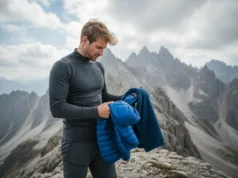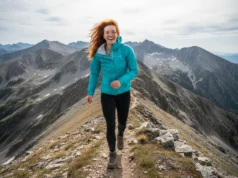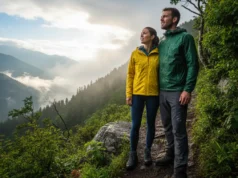In this article
Imagine you’re three hours into a steep climb. The sun is beating down, but a cold wind whips across the ridge. You’re sweating, but you’re also starting to feel a chill set in. This is the moment where your choice of long-sleeve shirt stops being about style and becomes a critical piece of your survival gear. The right backpacking long sleeve shirt is the unsung hero of your layering system, working tirelessly as your primary base layer to manage moisture, provide essential sun protection, and keep you comfortable. This guide is your blueprint for choosing that hero, transforming your approach from simple gear guesswork into a system-based approach for building a strategic layering system for comfort and safety on the trail.
We’ll help you pinpoint exactly what to look for by breaking down the three core backpacker types—from the Thru-Hiker to The Ultralight Specialist and The Weekend Warrior. You will master the material science, understanding the non-negotiable differences between merino wool and quick-drying synthetic blends and how they impact moisture, odor resistance, and durability. We will decode the features, explaining why a high UPF rating is crucial and how design elements like a sun hood and thumbholes can make or break your comfort during multi-day trips. Finally, you’ll get our trail-tested recommendations, tailored to your specific backpacking scenario, from ultralight wonders to bombproof workhorses.
How to Choose the Right Backpacking Long Sleeve Shirt: An Expert’s Framework
This framework is designed to arm you with the objective knowledge needed to make a smart, confident choice. It will turn you from a consumer into an informed gear analyst, capable of dissecting any shirt on the rack and knowing if it’s right for you. This is The Backpacker’s Layering Blueprint in action.
Why is Moisture Management a Backpacker’s Top Priority?
First, understand that moisture management is a safety function, not just a comfort feature. It is the absolute key to preventing both hypothermia in cold weather and overheating in hot weather. When you exert yourself, your body produces sweat to cool down. If that sweat stays trapped against your skin by the wrong fabric, it can have dangerous consequences. The science behind how performance fabrics solve this is called “wicking,” which works through a process known as capillary action. High-performance, quick-drying fibers are engineered to pull sweat away from your skin and move it to the fabric’s outer surface, where it can evaporate quickly.
Synthetic blends of polyester and nylon are hydrophobic, meaning they inherently repel water. This makes them excel at moisture-wicking without absorbing it. Merino wool, on the other hand, operates differently; it can absorb a significant amount of moisture into its core yet continue to provide insulation and feel relatively dry to the touch. This brings us to the most critical rule in outdoor apparel: the “Cotton Kills” adage. Cotton, even organic cotton, is the polar opposite of a performance fabric. It absorbs moisture like a sponge, loses all its insulating properties when wet, and actively robs your body of heat, dramatically increasing your risk of hypothermia, a danger well-documented in studies on thermoregulation and textiles. This fundamental principle is the cornerstone of an effective layering system, which always begins with a moisture-wicking base layer that gets moisture off your skin.
Pro-Tip: Always check the fabric tag on a potential hiking shirt. Some casual “performance” blends will sneak in a small percentage of cotton (5-10%). For true backpacking use, where your safety depends on moisture management, aim for a blend that is 100% synthetic, wool, or a combination of the two.
Now that you understand how a shirt keeps you dry and safe, let’s look at how it withstands the abuse of the trail itself.
How Do I Balance Durability, Weight, and Comfort?
When selecting a backpacking long sleeve shirt, you’ll always encounter a core trade-off triangle: Weight, Durability, and Cost/Comfort. The hard truth is that you can almost always optimize for two of these attributes, but rarely all three. A superlight, most comfortable shirt is often less durable, while a bombproof shirt ready for a thru-hike might be heavier or more expensive.
Durability on the trail isn’t just about surviving a single trip; it’s about withstanding the constant abrasion from backpack straps grinding against your shoulders and back for hours on end, day after day. It’s also about resisting snags from branches and rocks. In the world of textiles, Nylon is the undisputed king of durability, followed closely by Polyester. Natural fibers like merino wool or alpaca fiber are significantly less durable and more prone to developing holes from friction over time.
For ultralight backpacking, weight is the next critical factor, as every ounce in your pack weight compounds over a long day, increasing fatigue and the risk of injury. The lightest fabrics on the market are marvels of engineering, but they are often the most delicate. Finally, comfort isn’t just a luxury; it’s a performance metric. We define it through objective factors: the “hand-feel” or softness of the soft fabric, the construction of the seams—look for flatlock seams that lie flat to prevent chafing—and mobility, which often comes from a small amount of stretch material like Spandex woven into the fabric.
| Feature | Merino Wool | Polyester | Nylon |
|---|---|---|---|
| Drying Speed | ⭐ Fair | ⭐⭐⭐⭐⭐ Excellent | ⭐⭐⭐⭐⭐ Excellent |
| Durability | ⭐⭐ Good | ⭐⭐⭐ Very Good | ⭐⭐⭐⭐⭐ Excellent |
| Odor Resistance | ⭐⭐⭐⭐⭐ Excellent | ⭐⭐ Fair | ⭐⭐ Fair |
| Cost | ⭐⭐ Expensive | ⭐⭐⭐⭐ Affordable | ⭐⭐⭐ Moderate |
Once you’ve balanced a shirt’s physical properties, the next crucial factor is how it protects you from the invisible threat of the sun, something the Skin Cancer Foundation emphasizes as a key part of outdoor safety.
What Do UPF Ratings and Key Features Actually Mean for a Hiker?
Understanding a shirt’s technical features allows you to see it not just as fabric, but as a piece of specialized equipment. The Ultraviolet Protection Factor, or UPF rating, is a lab-tested measure of how much UV radiation a fabric blocks from reaching your skin. A shirt with a UPF 50+ rating is providing excellent full coverage, blocking over 98% of the sun’s harmful rays. To put that in perspective, a standard white cotton t-shirt has a UPF of around 5, and that number plummets when it gets wet. For hikers spending long days above treeline or in exposed desert environments, a high UPF rating (ideally UPF 30 or higher) is a non-negotiable safety feature and a core part of your broader sun protection system.
Odor resistance is another key performance metric, especially on multi-day trips. It’s important to know that sweat itself doesn’t smell; the odor comes from bacteria that thrive in the warm, moist environment of your shirt. There are two primary solutions to this problem. Merino wool possesses natural antimicrobial properties that inherently resist the growth of these bacteria. Synthetics, on the other hand, achieve odor control through specialized treatments, like the odor-control additives such as Polygiene® or HeiQ Mint odor control applied to fabrics.
Finally, functional features can dramatically enhance your comfort and safety. A well-designed “scuba” style hood on a sun hoody offers crucial sun protection for your neck and ears. Thumbholes allow you to extend the sleeve over the backs of your hands. The choice between a button-down and a pullover reflects a difference in philosophy: button-downs offer unparalleled ventilation and versatility with features like chest pockets, while pullovers offer layering simplicity and lower weight.
Pro-Tip: To maximize the life of your shirt’s odor-control treatment and water-repellent finishes (if any), wash it in cold water and hang it to dry. The high heat from a dryer can degrade these technical features over time.
With this expert framework in hand, you’re now ready to see how we applied it to find the best combination of shirts on the market.
Our Selection Process: How We Built This Guide
To build your trust, we want to be completely transparent about how this guide was created. Our commitment is to total objectivity. This guide isn’t based on our personal preferences or what’s trendy this season. It’s built on a data-driven framework derived from analyzing dozens of expert reviews from seasoned thru-hikers and gear labs, poring over material science reports, and synthesizing thousands of hours of real-world user feedback from across the hiking community.
Every shirt we considered was systematically scored against five core performance criteria: Moisture Management, Durability, Odor Resistance, Comfort, and Versatility. Alongside these performance metrics, we cataloged four key technical specifications: Material composition, Weight, UPF Rating, and Cost, ensuring we cover trail-tested gear for every climate, from hot weather on the Pacific Crest Trail (PCT) to cold weather layering in the Pacific Northwest. We looked at products from top brands like Patagonia, Arc’teryx, Mountain Hardwear, REI, and Smartwool.
Our selection process was two-fold. First, we identified the distinct needs of key backpacker “personas”—the ultralight specialist who counts every gram, the weekend warrior seeking maximum value, and the thru-hiker who demands bombproof reliability for the Appalachian Trail (AT). Second, we curated the top-performing products from our extensive database that best met the unique priorities of each of those hikers. This ensures that the shirt you see recommended here isn’t just a good shirt; it’s the right shirt for a specific backpacking scenario based on trip duration and pack weight.
Finally, a note on affiliate links. If you choose to purchase a product through one of our links, we may earn a small commission at no extra cost to you. This helps support our independent research and writing, but our recommendations are, and always will be, driven by performance and user value first.
The Best Backpacking Long Sleeve Shirts of 2025: Our Top Recommendations for Every Need
Here are our top picks, organized by the type of hiker you are. We’ve done the research and testing—these shirts are tested & reviewed—so you can make your final decision with complete confidence.
Our Top Picks for The Ultralight Specialist
The Ultralight Specialist lives by the mantra “ounces make pounds.” Every decision is filtered through the lens of lowest possible weight (measured in oz) and highest multi-functionality. This hiker willingly accepts potential trade-offs in long-term durability to achieve a lighter pack weight, enabling them to move faster and farther with less effort. Their ideal shirt for an ultralight 3-day kit is a featherlight, highly breathable second skin that provides sun protection and manages sweat without adding a single unnecessary gram.
Our Top Picks for The Weekend Warrior
The Weekend Warrior is the backbone of the hiking community. They seek the best overall price-to-performance ratio, prioritizing reliable comfort and solid sun protection for their one-to-three-night adventures in fair weather. They need gear that is functional, comfortable, and has enough versatility to go from the trail to the post-hike brewery without skipping a beat. Durability is important, but it doesn’t need to be thru-hike-apocalypse-proof. Their ideal shirt is a dependable, feature-rich workhorse that delivers great value.
Conclusion
Your long-sleeve shirt is your primary tool for thermoregulation, the engine of your entire layering system. To make the right choice, you must prioritize moisture-wicking fabrics like synthetic blends or merino wool and avoid cotton at all costs. You should match the material to your primary need: Nylon for ultimate durability, Polyester for its quick-drying prowess, and Merino Wool for unparalleled odor resistance on multi-day trips. For any significant sun exposure, a lab-tested UPF rating of UPF 30 or higher is a non-negotiable safety feature that provides more reliable sun protection than sunscreen alone. Finally, how to choose & combine long-sleeve shirts comes down to design—a minimalist pullover or a feature-rich button-down—based on your hiking style, balancing low weight and smooth layering against maximum utility and ventilation.
You’re now equipped with the expert knowledge for building a strategic layering system. Use this blueprint to choose the shirt that matches your hiking identity, and step onto the trail with the confidence that your gear is working as hard as you are.
Frequently Asked Questions about Backpacking Long Sleeve Shirts
What’s better for backpacking, merino wool or a synthetic shirt?
The best material for a hiking long sleeve shirt depends on your priorities and the conditions you expect. Choose merino wool if your top priorities are multi-day odor resistance, comfort across a wide temperature range, and a natural feel, making it ideal for cold weather layering. It’s the king of long trips where you can’t do laundry. Choose a synthetic shirt, like one made of polyester, if you need the absolute fastest drying time, superior durability against abrasion, and a more affordable price point. Synthetics are ideal for humid climates or trips where toughness is paramount.
Is a button-down shirt or a hoodie better for thru-hiking?
This choice reflects two different but equally valid hiking philosophies. Button-down shirts, like the popular Jolly Gear Triple Crown Button Down, offer unmatched ventilation control; you can unbutton the front, use roll-up sleeves, and pop the collar for sun protection, giving you a huge range of adaptability. They also often come with useful chest pockets. Hoodies, on the other hand, are typically lighter, simpler, and layer more smoothly under a rain jacket or mid-layers without the bulk of buttons and a collar. Many long-distance thru-hikers, particularly on hot and exposed trails like the PCT, have come to favor the feature-rich, highly adaptable button-down design.
Do I really need a UPF-rated shirt for hiking?
Yes, absolutely. For hiking in any exposed conditions—deserts, ridge lines, or above treeline—a shirt with a UPF 30+ rating should be considered a critical piece of safety gear. It provides consistent, reliable protection against harmful UV radiation that doesn’t sweat off, wear off, or require reapplication like sunscreen. This is especially important in high-altitude environments where the atmosphere is thinner and UV intensity is significantly greater. It is your most reliable first line of defense against the sun.
What is the most durable material for a hiking shirt?
Woven fabrics made from Nylon are generally considered the most durable and abrasion-resistant material for hiking shirts, making them an excellent choice for off-trail adventures or routes with a lot of overgrown brush. Synthetics like polyester, especially those in a ripstop polyester weave, are also very durable and offer a great balance of toughness and weight. Natural fibers like merino wool are the most delicate and are the most susceptible to developing holes from the friction of a backpack or contact with abrasive surfaces over time.
Risk Disclaimer: Hiking, trekking, backpacking, and all related outdoor activities involve inherent risks which may result in serious injury, illness, or death. The information provided on The Hiking Tribe is for educational and informational purposes only. While we strive for accuracy, information on trails, gear, techniques, and safety is not a substitute for your own best judgment and thorough preparation. Trail conditions, weather, and other environmental factors change rapidly and may differ from what is described on this site. Always check with official sources like park services for the most current alerts and conditions. Never undertake a hike beyond your abilities and always be prepared for the unexpected. By using this website, you agree that you are solely responsible for your own safety. Any reliance you place on our content is strictly at your own risk, and you assume all liability for your actions and decisions in the outdoors. The Hiking Tribe and its authors will not be held liable for any injury, damage, or loss sustained in connection with the use of the information herein.
Affiliate Disclosure: We are a participant in the Amazon Services LLC Associates Program, an affiliate advertising program designed to provide a means for us to earn advertising fees by advertising and linking to Amazon.com. As an Amazon Associate, we earn from qualifying purchases. We also participate in other affiliate programs and may receive a commission on products purchased through our links, at no extra cost to you. Additional terms are found in the terms of service.





